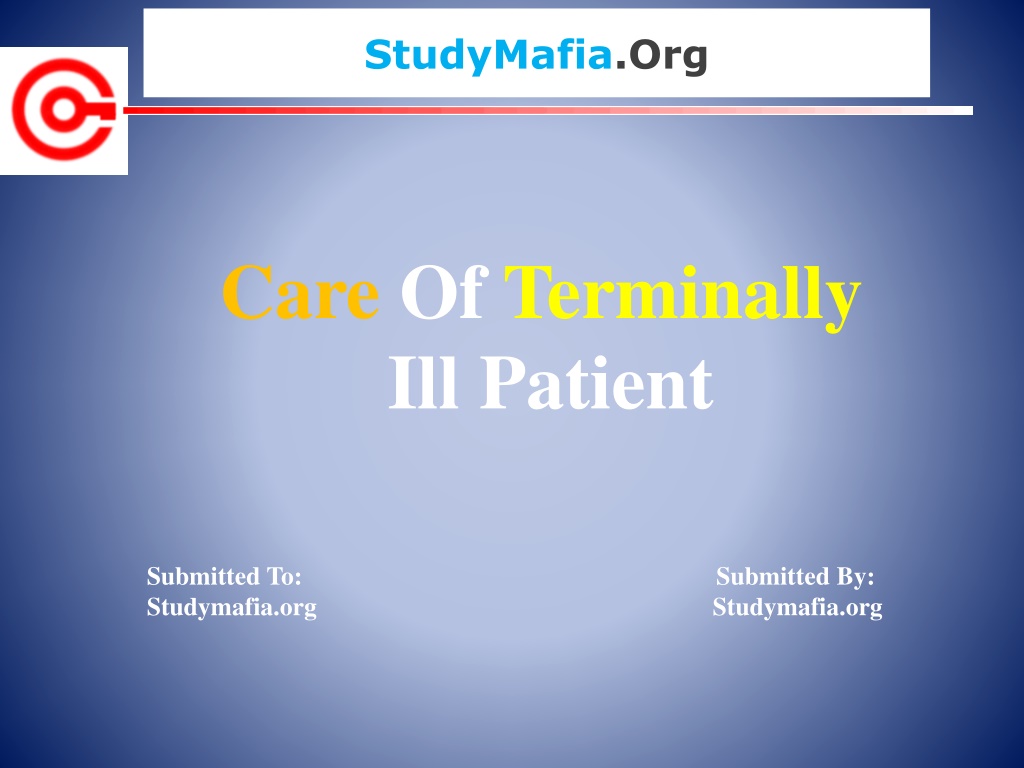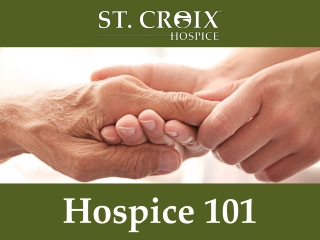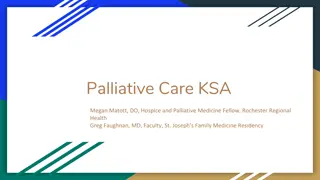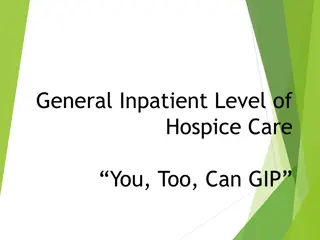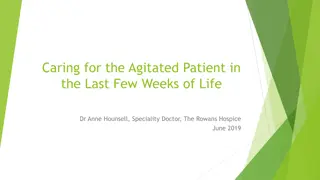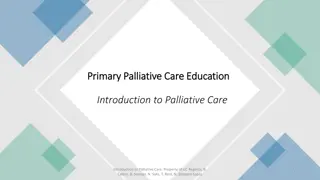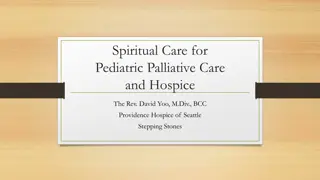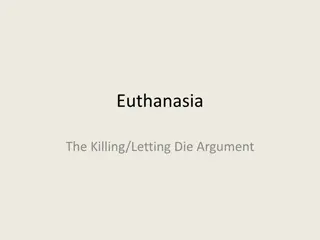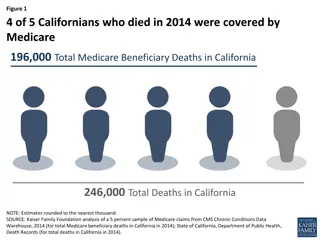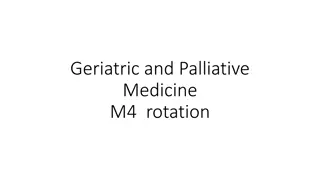Comprehensive Guide to Hospice Care for Terminally Ill Patients
Hospice care offers specialized support for individuals nearing the end of life, focusing on maximizing comfort and addressing physical, emotional, social, and spiritual needs. This guide covers the benefits, providers, financing, evaluation, and procedures of hospice care, emphasizing the goal of enhancing quality of life for patients and their families during this difficult time.
Download Presentation

Please find below an Image/Link to download the presentation.
The content on the website is provided AS IS for your information and personal use only. It may not be sold, licensed, or shared on other websites without obtaining consent from the author. Download presentation by click this link. If you encounter any issues during the download, it is possible that the publisher has removed the file from their server.
E N D
Presentation Transcript
StudyMafia.Org Care Of Terminally Ill Patient Submitted To: Studymafia.org Studymafia.org Submitted By:
Table Contents Introduction Benefits of Hospice Care Hospice Care Provider How is hospice care financed? Evaluation of Hospice Program Procedure of Hospice Care Conclusion 2
Introduction Hospice care is for people who are nearing the end of life. The services are provided by a team of health care professionals who maximize comfort for a person who is terminally ill by reducing pain and addressing physical, psychological, social and spiritual needs. To help families, hospice care also provides counseling, respite care and practical support. The goal is to support the highest quality of life possible for whatever time remains. 3
Benefits of Hospice Care Hospice care is for a terminally ill person who's expected to have six months or less to live. But hospice care can be provided for as long as the person's doctor and hospice care team certify that the condition remains life-limiting. Many people who receive hospice care have cancer, while others have heart disease, dementia, kidney failure or chronic obstructive pulmonary disease. 5
Benefits of Hospice Care Enrolling in hospice care early helps you live better and live longer. Hospice care decreases the burden on family, decreases the family's likelihood of having a complicated grief and prepares family members for their loved one's death. Hospice also allows a patient to be cared for at a facility for a period of time, not because the patient needs it, but because the family caregiver needs a break. This is known as respite care. 6
Hospice Care Provider Most hospice care is provided at home with a family member typically serving as the primary caregiver. However, hospice care is also available at hospitals, nursing homes, assisted living facilities and dedicated hospice facilities. No matter where hospice care is provided, sometimes it's necessary to be admitted to a hospital. For instance, if a symptom can't be managed by the hospice care team in a home setting, a hospital stay might be needed. 7
Hospice Care Provider Doctors:A primary care doctor and a hospice doctor or medical director will oversee care. Each patient gets to choose a primary doctor. This can be your prior doctor or a hospice doctor. Nurses: Nurses will come to your or your relative's home or other setting to provide care. They are also responsible for coordination of the hospice care team. Home health aides: Home health aides can provide extra support for routine care, such as dressing, bathing and eating. Spiritual counselors: Chaplains, priests, lay ministers or other spiritual counselors can provide spiritual care and guidance for the entire family. 8
Hospice Care Provider Social workers: Social workers provide counseling and support. They can also provide referrals to other support systems. Pharmacists: Pharmacists provide medication oversight and suggestions regarding the most effective ways to relieve symptoms. Volunteers: Trained volunteers offer a variety of services, including providing company or respite for caregivers and helping with transportation or other practical needs. Other professionals: Speech, physical and occupational therapists can provide therapy, if needed. 9
How is hospice care financed? Medicare, Medicaid, the Department of Veterans Affairs and private insurance typically pay for hospice care. While each hospice program has its own policy regarding payment for care, services are often offered based on need rather than the ability to pay. Ask about payment options before choosing a hospice program. 10
Evaluation of Hospice Program Is the hospice program Medicare-certified? Is the program reviewed and licensed by the state or certified in some other way? Is the hospice program accredited by The Joint Commission? Who makes up the hospice care team, and how are they trained or screened? Is the hospice medical director board certified in hospice and palliative care medicine? Is the hospice program not-for-profit or for profit? Does the hospice program have a dedicated pharmacist to help adjust medications? Is residential hospice available? 11
Evaluation of Hospice Program What services are offered to a person who is terminally ill? How are pain and other symptoms managed? How are hospice care services provided after hours? How long does it take to get accepted into the hospice care program? What services are offered to the family? What respite services are available for the caregiver or caregivers? What bereavement services are available? Are volunteer services available? If circumstances change, can services be provided in different settings? Does the hospice have contracts with local nursing homes? 12
Procedure of Hospice Care Supporting spiritual needs People who know they are near the end of life may reflect on their beliefs, values, faith or the meaning of life. They may have questions about how they will be remembered, or they may think about the need to forgive or be forgiven by another. Others may feel conflicted about their faith or religion. Supporting emotional needs A person nearing the end of life may be distressed or experience conflicting emotions. You can provide emotional support by listening and being present. Your physical presence sitting quietly or holding hands can be soothing and reassuring. 13
Procedure of Hospice Care Recognizing when death is near- While it's difficult to know when someone is going to die, there are common signs that may indicate the last days or hours of life. These may include: Restlessness, confusion or agitation Increased sleep or periods of drowsiness Loss of appetite Irregular breathing or pauses in breathing Swelling, coldness or blue coloring in the hands or feet Reports of seeing someone who has already died Gurgling or crackling sounds with breathing 14
Procedure of Hospice Care Providing comfort It's important to know steps you can take to provide comfort during the last days and hours before death. Not eating Feed small spoonfuls of food. Use ice chips or a damp sponge to keep the mouth moist. Dryness around the face Use a damp cloth to relieve dryness around the eyes. Apply lip balm or petroleum jelly to the lips. Labored breathing Gently turn the person's head, adjust pillows or raise the head of the bed. Use a cool-mist humidifier. Ask the medical team about medication or the use of oxygen. 15
Procedure of Hospice Care Skin irritation Gently apply lotion to dry skin. Learn how to move and adjust the person safely in bed to avoid the development of sores. Incontinence Learn how to change incontinence pads or ask about the use of a catheter. Agitation, confusion Speak calmly and be reassuring. Hold hands or use a gentle touch if it's comforting. Remind the person where he or she is and who is there. Ask the medical team for help if significant agitation occurs. Pain Give pain medication as directed. Ask the medical team to adjust medication if needed. 16
Conclusion To care for a dying person is an honor and privilege afforded few in our society. The services are provided by a team of health care professionals who maximize comfort for a person who is terminally ill by reducing pain and addressing physical, psychological, social and spiritual needs. To help families, hospice care also provides counseling, respite care and practical support. 18
References Google.com Wikipedia.org Studymafia.org Slidespanda.com
Thanks To StudyMafia.org
